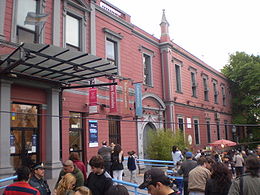
Centro Cultural Recoleta
Encyclopedia

Spanish language
Spanish , also known as Castilian , is a Romance language in the Ibero-Romance group that evolved from several languages and dialects in central-northern Iberia around the 9th century and gradually spread with the expansion of the Kingdom of Castile into central and southern Iberia during the...
: Centro Cultural Recoleta) is an exhibition and cultural events centre located in the barrio of Recoleta
Recoleta
Recoleta is a downtown residential neighborhood in the city of Autonomous City of Buenos Aires, Argentina; it is an area of great historical and architectural interest, due, particularly to the Recoleta Cemetery located there...
, Buenos Aires
Buenos Aires
Buenos Aires is the capital and largest city of Argentina, and the second-largest metropolitan area in South America, after São Paulo. It is located on the western shore of the estuary of the Río de la Plata, on the southeastern coast of the South American continent...
, Argentina
Argentina
Argentina , officially the Argentine Republic , is the second largest country in South America by land area, after Brazil. It is constituted as a federation of 23 provinces and an autonomous city, Buenos Aires...
.
It holds sculptures and exhibitions, as well as concerts and artistic presentations and workshops of diverse types.
in September/October 2006 it held the wildly successful onedotzero
Onedotzero
onedotzero is a contemporary, digital arts organisation with a remit to promote innovation across all forms of moving image and motion arts....
festival attracting over 20,000 people in 3 days for installations, live performances, screenings and music.
History
.jpg)
Franciscan
Most Franciscans are members of Roman Catholic religious orders founded by Saint Francis of Assisi. Besides Roman Catholic communities, there are also Old Catholic, Anglican, Lutheran, ecumenical and Non-denominational Franciscan communities....
s in 1716. The blueprints of the construction were drawn by Jesuit
Society of Jesus
The Society of Jesus is a Catholic male religious order that follows the teachings of the Catholic Church. The members are called Jesuits, and are also known colloquially as "God's Army" and as "The Company," these being references to founder Ignatius of Loyola's military background and a...
architects Juan Krauss and Juan Wolf, while the design of the façade
Facade
A facade or façade is generally one exterior side of a building, usually, but not always, the front. The word comes from the French language, literally meaning "frontage" or "face"....
and interiors are attributed to Andrés Blanqui.
The building, finished in 1732, is one of the oldest in the city. With the arrival of the May Revolution
May Revolution
The May Revolution was a week-long series of events that took place from May 18 to 25, 1810, in Buenos Aires, capital of the Viceroyalty of the Río de la Plata, a Spanish colony that included roughly the territories of present-day Argentina, Bolivia, Paraguay and Uruguay...
and the declaration of independence during the first part of the 19th century, the building changed purposes.
Manuel Belgrano
Manuel Belgrano
Manuel José Joaquín del Corazón de Jesús Belgrano , usually referred to as Manuel Belgrano, was an Argentine economist, lawyer, politician, and military leader. He took part in the Argentine Wars of Independence and created the Flag of Argentina...
founded a drawing school there, and since the 1870s it served as a shelter for the destitute. Torcuato de Alvear
Torcuato de Alvear
Torcuato de Alvear y Saenz de la Quintanilla was a 19th century Argentine conservative politician. He was the son of soldier and statesman Carlos María de Alvear and father of Marcelo Torcuato de Alvear, president of Argentina from 1922 to 1928.In 1880 Buenos Aires was declared the capital city...
, first mayor of Buenos Aires, beautified Recoleta as well as the cultural centre; Juan Antonio Buschiazzo
Juan Antonio Buschiazzo
Juan Antonio Buschiazzo was an Italian architect and engineer who contributed to the modernisation of Buenos Aires, Argentina in the 1880s and to the construction of the city of La Plata, the new capital of the Buenos Aires Province.Born in 1845 in Pontinvrea, Province of Savona, Liguria,...
gave it an Italian
Italy
Italy , officially the Italian Republic languages]] under the European Charter for Regional or Minority Languages. In each of these, Italy's official name is as follows:;;;;;;;;), is a unitary parliamentary republic in South-Central Europe. To the north it borders France, Switzerland, Austria and...
style and created the chapel currently used as an auditorium.
The second important renovation took place around 1980 by Clorindo Testa
Clorindo Testa
Clorindo Manuel José Testa is an Italian-Argentine architect and artist. He graduated from the School of Architecture at the Universidad de Buenos Aires in 1948....
, Jacques Bedel and Luis Benedit, when the building was planned as a cultural centre.

